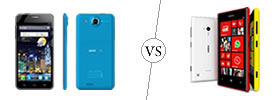Difference between SBI and ICICI
Key difference: SBI is the largest and oldest bank in India. ICICI is fairly new. SBI is state owned and operated, ICICI is privately owned.
 The State Bank of India (SBI) and ICICI Bank are the top two largest banks in India, respectively. They are followed by their competitors, the Punjab National Bank and HDFC Bank. SBI is the largest and oldest bank, dating back centuries, whereas, ICICI is comparatively fairly new.
The State Bank of India (SBI) and ICICI Bank are the top two largest banks in India, respectively. They are followed by their competitors, the Punjab National Bank and HDFC Bank. SBI is the largest and oldest bank, dating back centuries, whereas, ICICI is comparatively fairly new.
SBI dates back to British India. Its ancestry can be traced to the Bank of Calcutta which was founded in 1806, as well the Bank of Bombay (1840) and the Bank of Madras (1843). In 1921, these three amalgamated into the Imperial Bank of India. In 1955, the Imperial Bank of India became the State Bank of India.
Also, Industrial Credit and Investment Corporation of India (ICICI), a financial institution was formed in 1955 as a joint-venture of the World Bank, the Government of India and representatives of Indian industry. In 1994, ICICI Limited promoted ICICI Bank as its wholly-owned subsidiary. The principal objective was to create a development financial institution for providing medium-term and long-term project financing to Indian businesses. This was done in order to create a diversified financial services group offering a wide variety of products and services.

In 1999, ICICI become the first Indian company and the first bank or financial institution from non-Japan Asia to be listed on the NYSE. In 2002, ICICI merged with ICICI Bank and two of its own wholly-owned retail finance subsidiaries, ICICI Personal Financial Services Limited and ICICI Capital Services Limited. ICICI Bank is now the second largest bank in India by assets and third largest by market capitalization.
Still, not to be outdone, SBI is considered as one of the largest financial institutions in the world. According to Forbes, SBI is the 29th most reputed company in the world. In India, it has a market share of 20% among Indian commercial banks in deposits and loans. In comparison to ICICI Bank, SBI pays a higher savings interest rate and a lower loan rate. It also put a lot of emphasis on personal relations. However, an account with ICICI Bank has become somewhat of a status symbol. ICICI Bank is thought to provide better quality services, but is known to be strict in cases of minimum balances and returns the check if minimum balance requirements are not met. It takes a very professional approach towards its customers; some criticize this, claiming the employees appear cold.
However, being the top public sector bank in India, SBI had become somewhat complacent, but SBI has now modernized over the last decade and is offering services on par with ICICI. Still, ICICI is progressing at a fast rate, and may overtake SBI in the near future. In 2012, ICICI’s deposits increased 200%, five times more than SBI’s, and its revenue grew seven times that of SBI’s revenue growth of 30%.
A detailed comparison includes:
|
|
SBI |
ICICI Bank |
|
Type of bank |
Public sector (government owned) |
private sector |
|
Established in |
1955; ancestry to British India, the Imperial Bank of India, and the Bank of Calcutta founded in 1806 |
ICICI formed in 1955; ICICI Bank formed in 1994 |
|
Traded as |
NSE: SBIN BSE: 500112 LSE: SBID BSE SENSEX Constituent |
BSE: 532174 NSE: ICICIBANK NYSE: IBN BSE SENSEX Constituent |
|
Ranking (according to assets) |
Largest bank in India |
Second largest bank in India |
|
Branches (in India) |
14,119 branches; 21,500 branches including branches of associate banks. |
2,768 branches |
|
ATMs (in India) |
Over 21,000 ATMs, over 45,000 including associate banks |
9,363 ATMs |
|
Presence |
37 countries |
19 countries |
|
Products |
Credit cards, Consumer banking, corporate banking, finance and insurance, investment banking, mortgage loans, private banking, wealth management |
Credit cards, Consumer banking, corporate banking, finance and insurance, investment banking, mortgage loans, private banking, wealth management |
|
Assets (in 2012) |
US$ 360 billion |
US$ 93 billion |
|
Revenue (in 2012) |
US$ 37 billion |
US$ 5.65 billion |
|
Profit (in 2012) |
US$ 3.2 billion |
US$ 1,27 million |
|
Number of Employees (in 2012) |
292,215 |
58,276 |
Image Courtesy: cardekho.com, investmentkit.com









Add new comment